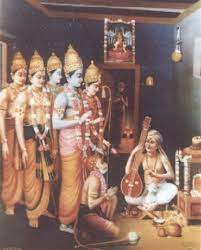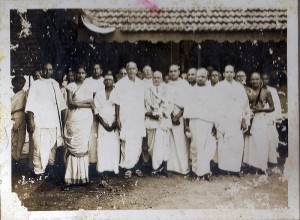Our dharma extols and worship a Guru to an extent that he is always treated synonymously with the ever pervading Almighty. Svetashvatara Upanishad, one among the celebrated 108 Upanishads says an aspirant must have unbiased worship towards his Guru and he is to be considered as a God incarnate itself. This is the only way through which he can attain the eternal bliss, prescribes this Upanishad. Advayataraka Upanishad, comparatively a lesser-known among the 108 Upanishads gives a meaning for the sabda “Guru”. The syllables ‘gu’ and ‘ru’ denotes darkness and dispeller respectively. Hence ‘Guru’ denotes a person who dispels darkness.
This truth as certified by Upanishads was sincerely followed by the disciples belonging to all the branches of Vedic dharma and we do find this idea percolating into the practitioners of Gandarva Veda also. Guru keertana-s and ashtaka-s composed by Valajapettai Venkataramana Bhagavathar on his guru Tyagaraja Svamigal is quite famous. We also see a mangalam on Svamigal composed by two of his disciples – Venkataramana Bhagavathar and Manambuchavadi Venkatasubbaier.
There exist a lesser-known set of Guru kritis composed by Tanjavur Quartette on their teacher Sri Muthuswamy Dikshitar and they can be collectively called as Sri Guruguha Navaratnamalika.
Tanjavur Quartette and Sri Muthuswamy Diksitar
Unlike Svamigal, Diksitar was peripatetic and this ambulant nature made him to spread his music at various places. Whereas disciples from distant places swarmed at Tiruvayyaru and learnt from Svamigal, Diksitar planted his seed at various places which later blossomed to give flowers of various colour and shapes. One such set of disciples, who has learnt from Diksitar during his stay as a court musician in Tanjavur is Chinniah, Ponniah, Sivanandam and Vadivelu, commonly called as Tanjavur Quartette. They hail from a musical family and further honed their skills by learning from Diksitar for a period of approximately 8 years. As a tribute, they have composed and submitted this kritis into the lotus feet of their Guru.
The uniqueness of Sri Guruguha Navaratnamalika
A close introspection into the Guru kritis reveals they are strategically different from the works composed by the disciples of Svamigal.
- All these kritis are composed in Telugu and are on either Lord Brhadiswara or Devi Brhadiswari.
- Excluding a few phrases, these kritis do not deify their teacher. But it can be well perceived that their mental image about their Guru is exactly the same as mentioned in the Upanishad.
- Extra-ordinary parallelism is seen between these nine kritis and the kritis of Diksitar. In other words, these nine kritis stand out significantly from the rest of their creations! Perhaps, they could have felt, composing in the style followed by Guru would be a better tribute to show that He has bequeathed his wisdom to them.
As the name indicates, this set comprises of nine compositions set to nine different ragas:
Sri guruguha murthiki – Dhunibinnasadjam – Rupakam – Raganga raga 9
Mayatheetha svarupini – Mayamalavagowla – Rupakam – Raganga raga 15
Sri karambu – Kambhoji – Kantachapu
Sarasakshi – Sailadesakshi – Adhi – Raganga raga 35
Paramapavani – Varali – Rupakam – Raganga raga 39
Needu padame – Pantuvarali – Rupakam – Raganga ragam 45
Sri rajarajeswari – Ramamanohari – Adhi – Raganga ragam 52
Saatileni guruguhamurthini – Purvikalyani – Misrachapu – Raganga ragam 53
Sarekuni padamule – Chamaram – Rupakam – Raganga ragam 56
The kriti Mayateetha svarupini, as interpreted from Sangita Sampradaya Pradarshini can be viewed here.
It is surprising to see that all of them are raganga ragas (another term used to refer melakarta) except the kriti in Kambhoji. To approach it more academically, even Kambhoji can be considered as a raganga raga as it was considered as a mela by few composers in the past. A gitam by Paidala Gurumurthy Sastri, who was an elder contemporary of Quartette can be cited as an example.
A close observation reveals another interesting finding; four of the nine ragas take the svaras suddha dhaivatam and kakali nishadham (raganga ragas 9,15,39 and 45). Is this merely a coincidence?
The parallelism between Navaratnamalika and the kritis of Dikshitar
As mentioned above, the compositional style unexceptionally resembles that of Dikshitar. This gets more visible by the following discussion.
Raga mudra is seen in all except the kritis in Kambhoji and Purvikalyani.
Five out of these nine compositions are set in pallavi-anupallavi format, a common feature seen in the kritis of Diksitar (these are now called as samasti charana kritis).
Madhyamakala sahityam is seen in all the kritis excluding the kritis in Sailadesakshi and Purvikalyani.
A chittasvaram is affixed to many kritis in this set.
Has a graha svaram segment (only in the Dhunibinnasadjam kriti).
The raga structure portrayed in these kritis correspond exactly with the lakshana seen in the kritis of Diksitar as notated by Subbarama Diksitar.
All these kritis bear the mudra ‘guruguha’.
Guruguha mudra
Though this mudra has become synonymous with Diksitar, we do see this mudra being used by other composers. This mudra can be seen in some compositions of Subbarama Diksitar and Ambi Diksitar, other than the Quartette. In these nine kritis, this mudra is suffixed with phrases like ‘daasudaithi’, bhaktudani and sadhbhaktudani.
Only two kritis use a different form of this mudra and they give an internal reference regarding their relationship with Diksitar. The kriti in Binnasadjam begins as ‘sri guruguhamurtiki ne sishyudai yunnanura’, wherein the composer declares he was a disciple of Diksitar. Another personal reference is seen in the kriti ‘saatileni guruguhamurti’ wherein he says he is acquainted with his Guru for a considerable period of time (aa naatanundi).
Sources
We have three sources to study and analyse these kritis. The primary one is the text “Tanjai Peruvudaiyan Perisai” published by the descendants of Quartette. To the limited knowledge of this author, this is the first text to give these kritis in notation and name them as Navaratnamalika. Second is “Sangita Sampradaya Pradarshini” of Subbarama Diksitar and the third is the manuscripts believed to have been written by Quartette and now in the possession of Sri Sivakumar, a descendant of Quartette who graciously shared to do this analysis.
The notated version of all these nine kritis can be seen in the first source and only four kritis are notated in the text by Subbarama Diksitar. Subbarama Diksitar, in his treatise, has explained 72 raganga ragas and their janyas, practically by illustrating with the kritis of Muthuswamy Diksitar. Strangely for 4 raganga ragas (Dhunibinnasadjam, Siva Pantuvarali, Ramamanohari and Chamaram), no kriti of Diksitar was affixed. Instead, he has given the kritis of Ponniah as an authority to understand the ragas Dhunibinnasadjam, Ramamanohari and Chamaram (though Quartette in general were given the credit as the composer of these nine kritis, Subbarama Diksitar specifically mention the three kritis given by him as the creations of Ponniah). Siva pantuvarali is devoid of any kriti.
At the outset, no significant differences can be seen between these two texts with respect to the raga lakshana excluding the kriti in Ramamanohari. The raga lakshana seen in the kriti ‘sri raja rajeswari’, in the version given by Subbarama Diksitar is more in line with the Ramamanohari gitam seen in Samparadaya Pradarshini. Also, only Subbarama Diksitar has given a chittasvaram for Ramamanohari and Chamaram kritis. The graha svaram segment seen in the Dhunibinnasadajam kriti too is given only by Subbarama Diksitar.
Two inferences can be drawn from these findings – the descendants of Quartette have taken diligent efforts to preserve the compositions of their ancestors and Subbarama Diksitar, though belong to a different lineage has given the versions learnt and / or known to him earnestly.
Manuscripts
Versions seen in the manuscripts too correspond extraordinarily well with the other sources. Few striking differences are seen:
- Pantuvarali is mentioned as the raga taking sadharana gandhara corresponding to the raganga raga 45 (this is given as the raga taking antara gandhara corresponding to melam 51 in the text ‘Tanjai Peruvudaiyan Perisai’).
- The kriti ‘sri raja rajeswari’ has few special phrases that are seen in the gitam given in Sangita Sampradaya Pradarshini.
- The manuscript gives different versions for two kritis – sri karambu and saatileni guruguha murti. ‘Sri karambu’ is mentioned as the raga taking the svaras of Kanakambari, raganga raga 1 and the raga for ‘saatileni guruguhamurti’ is given as Nata, which also serves as a raga mudra. Sivakumar opines that this is a common pattern observed with the Quartette; to tune a single sahityam to two different ragas and to fix two different sahityam into a single tune.
Summary
Rather than praising their Guru, Quartette has followed a different technique of paying tribute to their Guru. They have incorporated the special elements (like raga mudra, graha svaram segment and madhyamakala sahityam) of Diksitar kritis in these nine compositions to show His influence on them.
These nine kritis are an important source to understand the raga laskshana prevailed in the Diksitar family and their disciples. Having kritis in nine raganga ragas might be an indication that Quartette might have composed in other raganga ragas too and are to be identified.
Acknowledgement
I profusely thank Sri Sivakumar for allowing me to peruse the manuscripts said to be written by Tanjavur Quartette.
This article appeared in Sruti, April 2020 issue.






